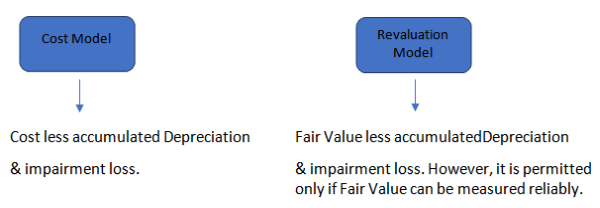IAS 16 Property, Plant and Equipment (PPE)
It covers the aspects of accounting for property, plant and equipment and represents the list of items falls into 'Tangible' Non-Current Assets.
Definition Of PPE:
• Tangible assets held for use in production or supply of goods or services or for rental purpose or for administrative purpose and
• Expected to be used more than one period.
Following assets fall outside the ambit of IAS 16:
• Biological Assets related to agriculture activity (IAS 41)
• Mineral Rights and Reserves (IFRS 6)
• PPE classified as Held for Sale (IFRS 5)

Recognition Criteria:
• Has potential Future Economic Benefits (FEB's).
• Can be measured reliably.
Components of Cost Recognition:
• Purchase price less all type of trade discounts.
• Import Duties inclusive of all non-refundable taxes.
• Directly attributable costs of bringing asset to working condition.
• Initial Estimate of Cost of Dismantling the asset and restoration of site.
Initial Recognition:
PP&E are supposed to be recorded at Cost. However, there are two exceptions where they are recorded at Fair Value:
• Acquired in exchange for Non-Monetary Asset.
• Acquired in Business Combination.
Exchange of Assets:
Asset acquired through exchange transactions should be recognized at Fair Value unless:
• Transaction lacks Commercial Substance.
• Fair Value of assets are not appropriately measurable.
If the acquired asset has not been measured at Fair Value, the its cost is measured at the Carrying Amount of the asset given up.
Subsequent Measurement:
Standard offers two possible treatments. Entity can record it either at-

Accounting for Revaluation:
|
Upward Revaluation |
Downward Revaluation |
|
• Increase must be recognized in P&L to the extent it reverses revaluation decrease. • Recognize increase in Other Comprehensive Income (OCI) with the heading "Revaluation Surplus" |
• Decrease will be recognized in P&L as expense. • Recognize decrease in OCI to the extent of "Revaluation Surplus" previously recognized in respect of same asset. |
Revaluation Surplus disclosed under the heading OCI will be transferred to 'Retained Earnings' when asset is fully Depreciated or Derecognized.
The frequency of Valuation depends on the Volatility of Fair Values of individual items of PP&E.
More volatile Fair Values, more frequently revaluations supposed to be carried out.
Overhauls:
When an asset requires regular overhauls/major inspection for faults, then such cost is treated as an additional component and required to be depreciated over the period of asset's useful life.
Retirement and Disposals:
When an asset is permanently withdrawn for use or sold/scrapped, and no future economic benefits are expected, then it should be withdrawn from PP&E.
Gains or Losses on disposal should be recognized in P&L as income/expense. An entity cannot classify gain as revenue on disposal of specific item of PP&E.
Depreciation:
It is a result of systematic allocation of depreciable amount of an asset over its useful life.
Depreciable Assets are assets which:
• Are expected to be used in more than one accounting period.
• Have limited Useful Life.
• Held by an entity for production of supply of goods/services, for rental & administrative purpose.
Useful Life:
• Based on assets expected utility.
• Estimation of useful life is a matter of judgement.
Factors considered in determining Useful Life:
• Expected physical wear and tear.
• Obsolescence
• Legal or other limits on use of assets.
Depreciation Methods:
Methods should reflect pattern in which assets Future Economic Benefits (FEB's) are expected to be consumed by entity. Following are the available methods:

Change in Depreciation Method will be considered as Change in Accounting Estimate as per IAS 8.
Componentization:
A part of an item of PP&E consists a significant portion in relation to the total cost of item, requires to be depreciated separately.
For instance:
In case of ship vessel, it will be appropriate to charge depreciation separately on Ship Engine and its vessel frame as both the parts have different useful life.
Disclosures:
• Fair Valuation measurement basis and assumptions, if any.
• Depreciation method followed.
• Component Wise Useful life determination.
• Reconciliation of carrying amount at the beginning/ending of period.








 CAclubindia
CAclubindia
